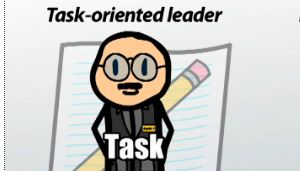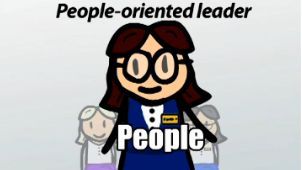Leadership Orientation: Task-Oriented & People-Oriented
After you watch the video and know the material, click HERE for the quiz.
As a leader, are you focused on getting the job done or on making people happy? This lesson will explain the difference between task-oriented leaders and people-oriented leaders to better help you decide.
Leadership Orientation
As part of a company-wide initiative at Don't Cha Be Talking Bout My Mama Inc., each manager has been asked to develop a team building activity aimed at increasing communication between departments. As a manager, do you start to break down the tasks that need to be done as part of the project and assign responsibilities to people based on who you think the right person for the job is? Or do you ask your employees what they would like to do as part of the project, checking if anyone has a talent or a preference that they want to explore? Are you someone who starts calling potential venues to see what dates are available and what each facility offers? Or do you begin by sending out a questionnaire to your employees to see what they would like to do for their team building activity? Do you set deadlines based on how long you think it should take? Or do you spend time talking to your employees and asking them personally how much time that they need? Do you review the budget and set aside funds for each area of the team builder how you see fit? Or do you ask staff how they prefer to spend their allotted money?
 |
Task-Oriented leaders
Task-oriented leaders are those leaders who are very much concerned with completing the task at hand. When given an assignment they immediately jump into it feet first and hit the ground running. Task-oriented leaders believe that if you want something done right, they need to do it themselves; they like being in control of the entire process. As such, task-oriented leaders will search out the best methods and resources to get the work done, make decisions relating to organizing and assigning work as an individual, and continuously monitor the performance of those with whom the manager assigns the work to.
 |
People-Oriented leaders.
People-oriented leaders are all about the subordinates. They believe the best way to get a job done is through people. People-oriented leaders take a very humanistic approach by recognizing and accommodating the needs of their employees as part of the work process. In fact, the very idea of having to develop a team building activity gets to the heart of people-oriented leadership whereby things such as teamwork, collaboration, group decision making, trust, and cohesion are all characteristic of the people-oriented manager.
 |
 |
Lesson Summary
Let's review. Just like Bobby Brown said 'it's my prerogative,' as a leader, you can decide what your preference is on the most effective way to get work done. This is known as your leadership orientation.
For those of you who believe the best way to get work done is by controlling it yourself, you are a task-oriented leader. Task-oriented leaders will search out the best methods and resources to get the work done, make decisions relating to organizing and assigning work as an individual, and continuously monitor the performance of those with whom the manager assigns the work to.
However, if you believe that it takes an army to accomplish a task and you like to make your army happy, you are a people-oriented leader. People-oriented leaders believe the best way to get the job done is through people. These leaders take a very humanistic approach by recognizing and accommodating the needs of their employees as part of the work process. Characteristics of the people-oriented leader include things such as teamwork, collaboration, group decision making, trust, and cohesion.